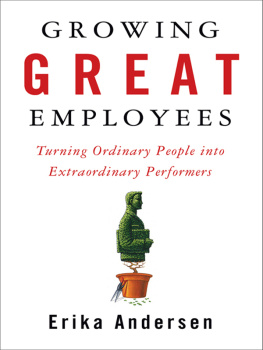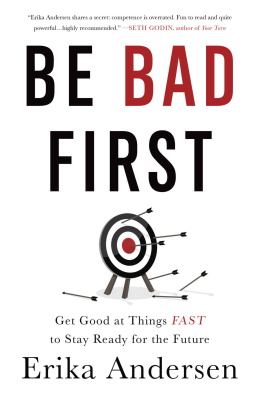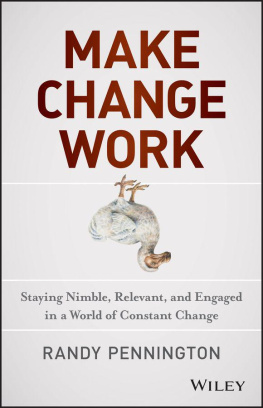Contents
Guide
Page List
CHANGE
FROM THE
INSIDE OUT

Change from the Inside Out
Copyright 2021 by Erika Andersen
All rights reserved. No part of this publication may be reproduced, distributed, or transmitted in any form or by any means, including photocopying, recording, or other electronic or mechanical methods, without the prior written permission of the publisher, except in the case of brief quotations embodied in critical reviews and certain other noncommercial uses permitted by copyright law. For permission requests, write to the publisher, addressed Attention: Permissions Coordinator, at the address below.

| Berrett-Koehler Publishers, Inc.
1333 Broadway, Suite 1000
Oakland, CA 94612-1921
Tel: (510) 817-2277, Fax: (510) 817-2278
www.bkconnection.com |
Ordering information for print editions
Quantity sales. Special discounts are available on quantity purchases by corporations, associations, and others. For details, contact the Special Sales Department at the Berrett-Koehler address above.
Individual sales. Berrett-Koehler publications are available through most bookstores. They can also be ordered directly from Berrett-Koehler: Tel: (800) 929-2929; Fax: (802) 864-7626; www.bkconnection.com
Orders for college textbook/course adoption use. Please contact Berrett-Koehler: Tel: (800) 929-2929; Fax: (802) 864-7626.
Distributed to the U.S. trade and internationally by Penguin Random House Publisher Services.
Berrett-Koehler and the BK logo are registered trademarks of Berrett-Koehler Publishers, Inc.
First Edition
Hardcover print edition ISBN 978-1-5230-0039-5
PDF e-book ISBN 978-1-5230-0040-1
IDPF e-book ISBN 978-1-5230-0041-8
Digital audio ISBN 978-1-5230-0042-5
2021-1
Book design and producton: BookMatters; copyediting: Amy Smith Bell; proofing: Janet Reed Blake; indexing: Leonard Rosenbaum; graphic design: Susan Malikowski, DesignLeaf Studio; cover design: Rob Johnson, Toprotype Inc.
My small flockheart, mind, body, soulrises together, wheels away
On a touch, a laugh;
Heads unerringly to that warmest place,
Us.
CONTENTS
PREFACE
First, Why You Need This Book
Unless youve been living on another planet, the past few years have shown that were in a time of unimagined, unrelenting, and ever-increasing change. And were not very good at it. This book can help.
For more than thirty years, my colleagues and I at Proteus have been helping people clarify and move toward their hoped-for future. Over the past decade weve focused especially on supporting clients through the individual and organizational changes they need to make in order to achieve those envisioned futures. In doing this work, we discovered something simple, predictable, and powerful: the mindset-based shift that each of us must go through in order to make any change.
Throughout this book Ill share that process with you: what that mindset shift is, how it works, and what gets in the way of making it. More important, Ill explain practically how to make that shift faster, easier, and less painful. Well focus on how you can make that mindset shift for yourself; how you can support those you lead to make that shift; and finally how you can catalyze and cascade that shift throughout your whole organization. Thats good news for you as a leader and for everyone in your organization. Youll be able to use the understanding, tools, and approaches outlined throughout this book to guide your people through change in a way that builds their understanding and buy-in and supports their success. At the same time youll be able to focus clearly on the nuts-and-bolts steps necessary to execute any major transformationmaking organizational change less disruptive and more beneficial for your employees and your business as well as for those who look to your business for products and services.
In other words, this book can help you, your people, and your organization become more change-capablebetter able to make the changes facing you now and to continue making the necessary changes in response to our ever-changing world. Lets get started.
ONE
How Change Has Changed
We got our first TV when my little brother was a baby. I dont remember how it got into our sunroomwhether my parents picked it up at the store or someone delivered it. But one day it was just there, this beautiful shiny wooden console with the little rectangular glass screen. My mom turned the knob to on, adjusted the volume, and sat down with the baby. We three older kids sat on the floor, clustered around her feet. And suddenly there was sound and movement: a cartoon. My mother settled back with a sigh, Kurt asleep on her lap, and Kristi and David and I stared, mesmerized.
I dont remember being particularly astonishedI was only three, so everything in my life was new and interesting. I had no reference point for understanding what a huge change this was from everything pre-TV: the whole world brought into our house in this new and living way. My parents got it, though. I vaguely remember pieces of conversations, partly excited and partly proud, about the big changes in the world. It seemed to them that everything had sped up after The War (their name for World War II, always with initial caps implied). TV and antibiotics and everyday air travelthe future for sure, with new things happening all the time.
Yet, compared to today, the changes of sixty years ago were almost stately in their unfolding. We generally had time, back then, to get our minds and our habits completely adjusted to a change before it changed again. For instance, by the time most people in the United States, my folks included, acquired the next version of television technologya color TV to replace the old black-and-whitewe had all had almost a decade to incorporate television into our daily lives. And incorporate it we certainly had. It was our second stop after coming home from school: into the kitchen to scrounge a snack and say hi to Mom, then to the playroom to switch on the TV and watch Loony Tunes before doing our homework. Sunday nights, the whole family would eat popcorn and watch Bonanza, Gunsmoke, and The Ed Sullivan Show. In other words, we were completely ready for this next iteration of TV when it arrived. Being able to watch our favorite programs in living color, as the ads promised, was a cool though not shocking advance. The red, blue, green, and yellow fireworks at the beginning of Walt Disneys Wonderful World of Color were a delight, not a disruption.
In the middle of the twentieth century, this was the pace of most change. Things pretty much stayed the same, day-to-day and year-to-year; when they changed, they changed gradually. My dad and my friends dads mostly continued working at the same jobs, with the same companies; most of our moms stayed home and took care of us and the household, and perhaps did volunteer or community work. I went to the same high school my older siblings had attended, which my younger brother would attend after me. It may have seemed like a modern, fast-changing world to my parents, but big changes like the advent of TV were still far enough apart to feel like spice in a well-known dish. The world was a fairly stable place. We had a set of World Book encyclopediasthe mid-twentieth-century version of the Internetand every year the World Book company would send us an update for the previous year. All the important changes and discoveries for 1959 or 1962 fit easily into one slim volume.















